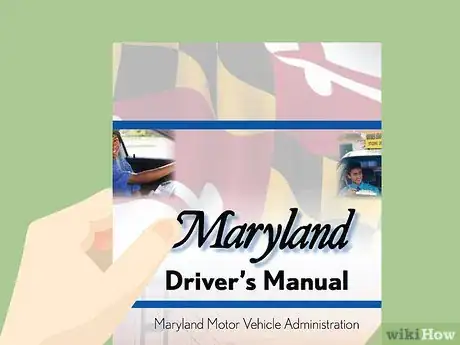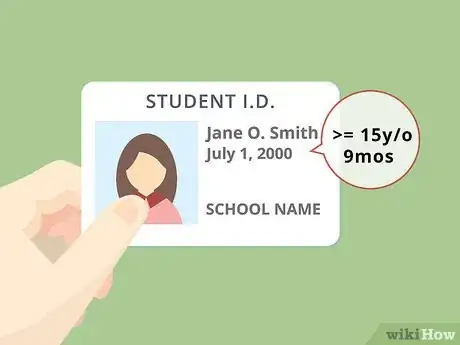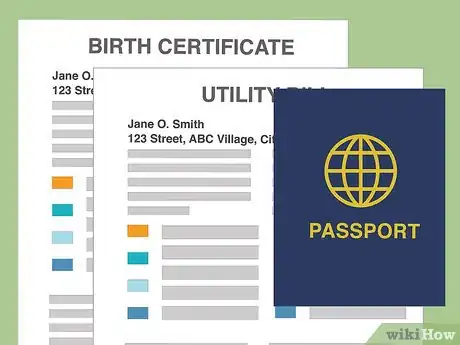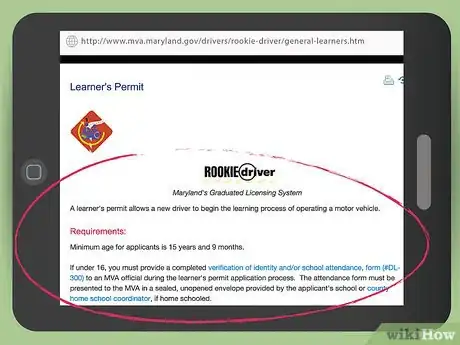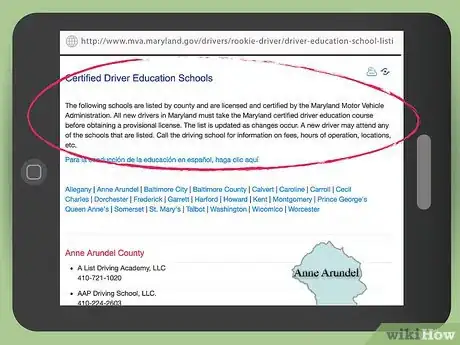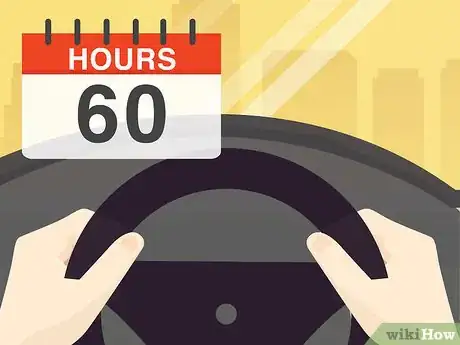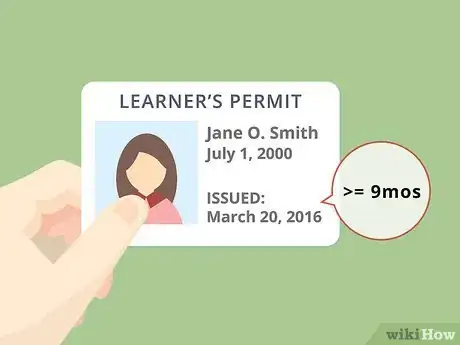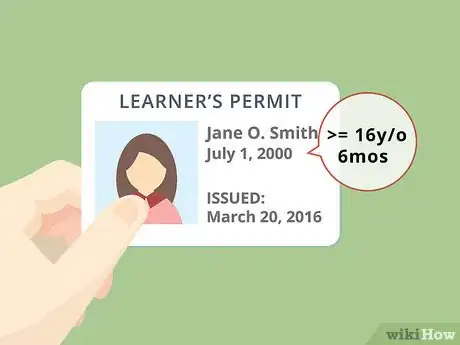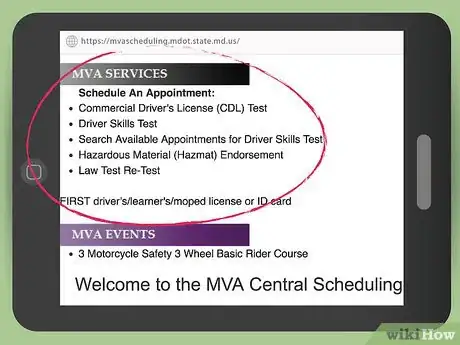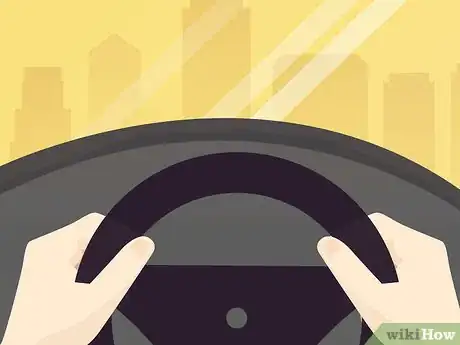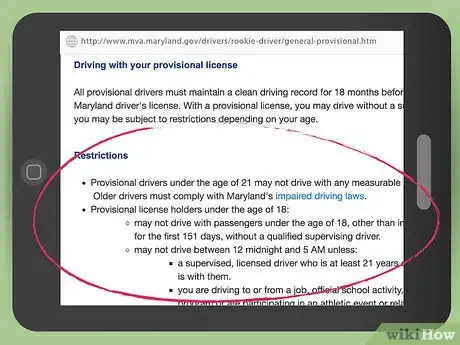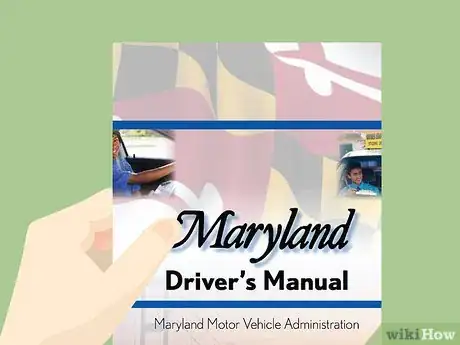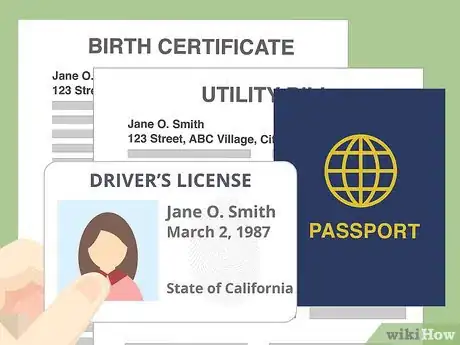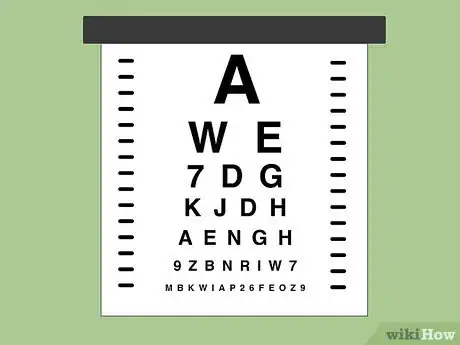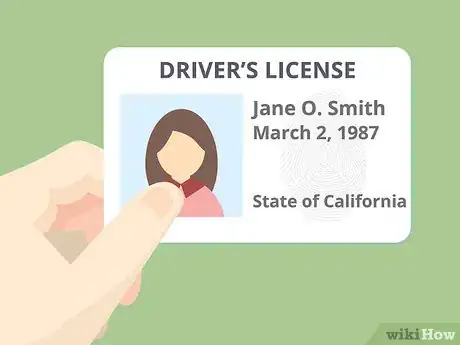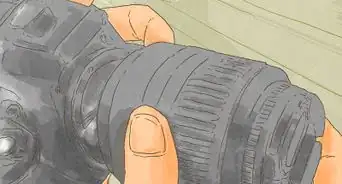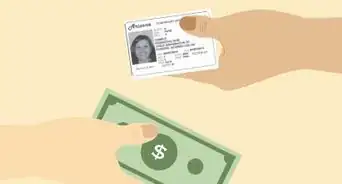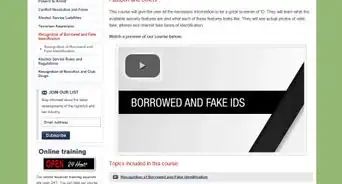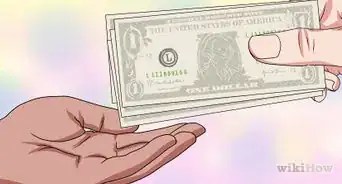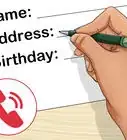This article was co-authored by Clinton M. Sandvick, JD, PhD. Clinton M. Sandvick worked as a civil litigator in California for over 7 years. He received his JD from the University of Wisconsin-Madison in 1998 and his PhD in American History from the University of Oregon in 2013.
There are 10 references cited in this article, which can be found at the bottom of the page.
This article has been viewed 78,872 times.
The state of Maryland requires everyone who drives to have a driver’s license. You can get your first learner’s permit at the age of 15 years and 9 months. After you drive successfully with your learner’s permit for 9 months, you can then obtain a provisional license, and eventually a regular license. If you have moved into Maryland from another state and you are already licensed, there are some simple steps to obtain a Maryland license and turn in your out-of-state license.
Steps
Getting a Learner’s Permit
-
1Study the Maryland Driver’s Manual. This is available online at https://mva.maryland.gov/Documents/DL-002.pdf or in any office of the Maryland Motor Vehicle Authority (MVA). The Maryland Driver's Manual contains information about the driving laws in Maryland, and will be necessary to pass the written knowledge test to get your learner's permit.[1]
-
2Be at least 15 years and 9 months old. In Maryland, you must be at least 15 years and 9 months old before you can apply for your learner’s permit. You will be able to begin taking a classroom instruction program earlier than this. But the minimum age to apply for your learner's permit is 15 years and 9 months.[2]Advertisement
-
3Gather the documents you will need and go to the MVA office. When you are ready, you will need to take the following information with you to your nearest full-service MVA office:[3]
- Your parents or legal guardian. This may not just be an older friend. One of your parents must be with you to sign your application.
- Proof of identification. You may take a U.S. Passport, or a birth certificate together with a social security card.
- Proof of Maryland residence. You need to bring two forms of proof of your residence in Maryland. This could be some combination of utility bills, canceled checks with a printed address, or bank statements to the address.[4]
- License fee. The fee for a learner’s license is $50. You can pay by credit card, cash, check or money order.
- If you are under 16 years old when you are applying for your learner’s permit, then you will also need to have the Learner’s Permit School Attendance Certification Form. You can download this form online at https://mva.maryland.gov/Documents/DL-300.pdf or pick one up from the MVA office. You may also be able to get one from your school’s office or guidance office. The form must be completed and signed by someone at your school. You then need to deliver it, in a sealed envelope, to the MVA official when you go for your learner’s permit.
-
4Take the required tests. When you report to the MVA for your learner’s permit, you will take a written knowledge test and a vision test.
- Written knowledge test. This will cover information that is in the Maryland Driver’s Manual regarding rules of the road and requirements for driving. The test consists of 25 questions and is administered on a computer. You will need a passing score of 85% in order to pass.[5]
- Vision test. To pass the vision screening, you must be able to score at least 20/40 eyesight in each eye, and a continuous field of vision (peripheral vision) of at least 140 degrees. A restricted license may be available for people with eyesight of 20/70 and field of vision of 110 degrees.
-
5Understand what your learner’s permit allows. With your learner's permit, you may drive only with a licensed driver over age 21 sitting in the seat next to you and you may not use any cell phone, whether hands-free or not, while driving.[6]
Transferring a Learner’s Permit into a Provisional License
-
1Complete a Driver’s Education Course. This may be a class sponsored by your high school, taught by a private company, or taught by your parents. If you parents teach you, they will need to meet all state requirements and submit a statement of compliance. This class must consist of at least 30 hours of classroom training, and 6 hours of on-the-road instruction.[7]
- You must have your learner’s permit before you are allowed to begin the driving training portion of any class.
- The MVA publishes a list of approved driver’s education programs on its website.
- The driving school will automatically transmit a record of your taking and passing the class to the MVA.
-
2Complete at least 60 hours of driving practice. With your learner’s permit, you must have a licensed adult over age 21 in the car with you, and you must keep a log of the hours you drive. At least 10 hours must be night driving, and the MVA recommends that you try to spend at least some time practicing driving in poor weather.[8]
- If you are over 25, you must still complete a practice log, but you are only required to show 14 hours of practice driving.
- The MVA publishes a “Rookie Driver: New Driver and Coach Practice Guide.” This Guide contains a form that you can use to record your practice hours. You will need to take that log with you when you return to the MVA office for your provisional license.
-
3Use your learner's permit for at least nine months. The purpose of the learner's permit is to give you the opportunity to drive, with a qualified adult in the car, and practice your driving skills before getting a provisional license. You are encouraged to get as much practice as you can during these nine months, so when you go for your driving skills test, you will have had plenty of practice.
-
4Be at least 16 years, six months old. Because you must drive with a learner's permit for at least nine months, and the earliest you can get it is 15 years and nine months, then the earliest possible age for the provisional license is 16 years and six months old. This provisional license will be the one you use until you turn 18.[9]
- You must hold the learner's permit for a minimum of 9 months. If you have any driving infractions during this time, your provisional license will be delayed.
-
5Contact the MVA office nearest you to schedule your driving test. You must schedule an appointment for your driving test. Tests are not available on a walk-in basis.
- From the MVA home page, www.mva.maryland.gov, select the link to “Locations” to find the MVA offices throughout the state.
- You can use the link at https://mvascheduling.mdot.state.md.us/ to schedule an appointment online, or you can visit the office where you wish to take the test and schedule an appointment in person.
-
6Attend your driving test. The driving skills test is a test of your ability to operate a car on the public roadways. If you have logged the required 60 hours of practice time, you should be ready for the driving test.
- You should come to the driving test with a vehicle that is in good operating condition and has at least a half-tank of gas.
- For your own comfort, this should be the vehicle that you spent most of the time practicing in.
- You and your parent (or other responsible adult whose car you are using) must complete and sign the Certification of Insurance and Authorization to Operate Vehicle. This form certifies that the car you will be using for the driving test is in good condition and is insured.[10]
-
7Understand what your provisional license allows. With a provisional license, the following rules apply:[11]
- You may only drive between 5:00 a.m. and 12:00 a.m., unless a licensed driver over 21 years old is with you, or you are driving to or from a job, official school activity, volunteer program or athletic event.
- You may not drive with passengers under the age of 18, except immediate family members.
- You may not use any cell phone, whether hands-free or not, while driving.
Transferring an Out-of-State License for a Maryland Driver's License
-
1Get and study the Maryland Driver’s Manual. This is available online or at any MVA office. Even though you may be an experienced driver, it is still recommended that you review the rules of driving in Maryland.[12]
-
2Gather the documents you will need and go to the nearest MVA office. When you are ready, you will need to take the following information with you to your nearest MVA facility:
- Your out-of-state driver’s license. If you do not have the actual license, you will need to bring a certified copy of your driving record from the Department of Motor Vehicles of your prior state of residence.
- Proof of identification. You should take with you either a U.S. Passport, or a birth certificate together with a social security card.
- Proof of Maryland residence. This may be a mortgage, lease, home insurance policy, credit card statements, or similar items. You need to bring two separate items of proof.
- License fee. The fee for the license is based on age or the number of years driving experience. Check with your nearest MVA office for the amount of the fee for your particular license. The fee is payable by cash, check or credit card.[13]
-
3Take the vision test. You must be able to demonstrate eyesight in each eye of 20/40 and peripheral vision of 140 degrees. Restricted licenses are available for people with eyesight of 20/70 and peripheral vision of 110 degrees.
- You may have your vision screening conducted at the MVA office, or you may have a doctor of your choice conduct the screening and complete the state’s vision form, which you take with you.[14]
-
4Surrender your out-of-state license. You may not keep an active, valid driver’s license from more than one state. When you surrender your out-of-state license, you will be issued your Maryland license.
Warnings
- Don't forget to wear your eye glasses or contacts⧼thumbs_response⧽
- Don't wear open-toe shoes⧼thumbs_response⧽
- You cannot use vehicles that show dashboard warning lights. The car must be in safe working condition.⧼thumbs_response⧽
References
- ↑ https://mva.maryland.gov/drivers/Pages/rookie-driver-general-learners.aspx
- ↑ https://mva.maryland.gov/drivers/Pages/rookie-driver-general-learners.aspx
- ↑ https://mva.maryland.gov/drivers/Pages/rookie-driver-general-learners.aspx
- ↑ http://www.dmv.org/md-maryland/drivers-permits.php
- ↑ http://www.mva.maryland.gov/about-mva/info/26300/26300-25T.htm
- ↑ https://mva.maryland.gov/drivers/Pages/rookie-driver-general-learners.aspx
- ↑ http://www.mva.maryland.gov/drivers/rookie-driver/driver-education-schools.htm
- ↑ http://www.mva.maryland.gov/_resources/docs/RD-006.pdf
- ↑ https://mva.maryland.gov/drivers/Pages/rookie-driver-general-provisional.aspx
- ↑ https://mva.maryland.gov/Documents/certification-of-insurance-and-authorization-to-operate-vehicle.pdf
- ↑ https://mva.maryland.gov/drivers/Pages/rookie-driver-general-provisional.aspx
- ↑ https://mva.maryland.gov/Documents/DL-002.pdf
- ↑ http://www.mva.maryland.gov/about-mva/fees/#DriverLicensing
- ↑ https://mva.maryland.gov/drivers/Pages/vision-requirements.aspx
About This Article
To obtain your driver’s license in Maryland, you’ll need to apply for a learner’s permit, pass a test to get your provisional license, then drive for 18 months before you get your full license. To get your learner’s permit, you need to be at least 15 years and 9 months old, and you'll need to pass a test on driving laws and safety. Once you have your learner's permit, you'll be able to drive with supervision from someone over 21 with their own full license. The next step is getting your provisional license. You’ll need to log at least 60 hours of driving practice with a driving course or with your parents. After 9 months, you can then take your provisional driving test. Once you pass that, you’ll have to drive for 18 months and have a clean record to upgrade to your full license. For more tips from our Legal co-author, including how to follow restrictions for your provisional license, read on!
